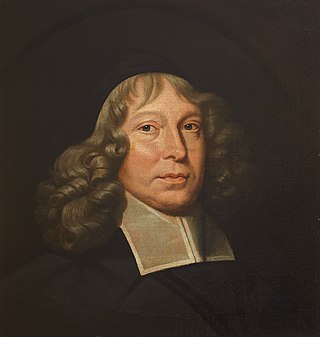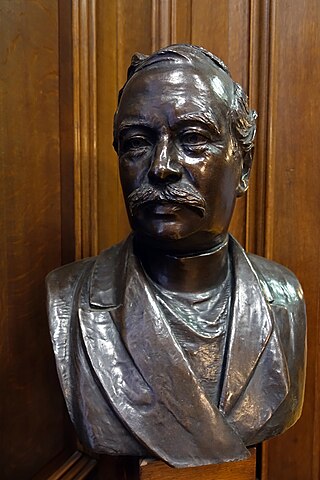Related Research Articles

The Dean Cemetery is a historically important Victorian cemetery north of the Dean Village, west of Edinburgh city centre, in Scotland. It lies between Queensferry Road and the Water of Leith, bounded on its east side by Dean Path and on its west by the Dean Gallery. A 20th-century extension lies detached from the main cemetery to the north of Ravelston Terrace. The main cemetery is accessible through the main gate on its east side, through a "grace and favour" access door from the grounds of Dean Gallery and from Ravelston Terrace. The modern extension is only accessible at the junction of Dean Path and Queensferry Road.

Sir George Adam Smith was a Scottish theologian. He was the Principal of the University of Aberdeen between 1909 and 1935 and an important figure in the United Free Church of Scotland.
The Scottish Renaissance was a mainly literary movement of the early to mid-20th century that can be seen as the Scottish version of modernism. It is sometimes referred to as the Scottish literary renaissance, although its influence went beyond literature into music, visual arts, and politics. The writers and artists of the Scottish Renaissance displayed a profound interest in both modern philosophy and technology, as well as incorporating folk influences, and a strong concern for the fate of Scotland's declining languages.

Samuel Rutherford was a Scottish Presbyterian pastor and theologian and one of the Scottish Commissioners to the Westminster Assembly.
Robert Douglas (1594–1674) was the only minister of the Church of Scotland to be Moderator of the General Assembly five times.
John Douglas was Protestant Archbishop of St. Andrews from 1571 to 1574. As was tradition from the fifteenth to the seventeenth centuries, the Archbishop also took on the role of Chancellor of the University of St Andrews, as the University had strong links with the Pre-Reformation church.

Brigadier General John Charteris, was a British Army officer. During the First World War, he was the Chief of Intelligence at the British Expeditionary Force General Headquarters from 1915 to 1918. In later life he was a Unionist Party Member of Parliament for Dumfriesshire.

John Wellwood (1853–1919) was a poet, writer, biographer and minister of the Church of Scotland. He was born at George Street, Glasgow on 18 December 1853. His father was John Wellwood, a commission agent, and his mother was Margaret Thomson. He was educated at Annfield School, Bridgeton, Glasgow and at the University of Glasgow. He chose the Church of Scotland instead of the United Presbyterian Church of which his parents were members, mainly because it "offered more scope for freedom and breadth of thought." After he was licensed by the Presbytery of Glasgow, he served as an assistant Minister at Auchterderran, at Glasgow Cathedral, and at Campbeltown. He was ordained on 5 April 1883 and immediately became minister in the parish of Drainie in the Presbytery of Elgin. Besides poetry, his interests included Liberal politics and musical composition and he composed several hymn tunes. On 26 April 1883, he married Isabella Herkless, the only daughter of William Herkless, Glasgow and the sister of Sir John Herkless, Principal of St. Andrews University. They had five sons and two daughters. Two of their sons were officers in Scottish regiments who died in action during the 1914-18 War. Wellwood remained Minister at Drainie till his death on 7 February 1919. The untimely death of his two sons contributed to his demise.

Andrew Wallace Williamson KCVO, was a Church of Scotland minister who was Dean of the Thistle. He was Moderator of the General Assembly in 1913.

John Hutchison was a Scottish sculptor based in Edinburgh. He was the son of an unnamed builder, and his artistic life began as a thirteen-year-old woodcarving apprentice. He attended art school in the evenings, then later became a student at the Trustees Academy. and attracted the patronage of its owner, Patrick Allan Fraser, who gave him commissions to fund his study in Rome. Although after Rome he continued to enjoy ancient Roman sculptural themes, he remained in Edinburgh for the rest of his life, working in wood, clay and marble, and concentrating on portraiture of Scottish people, and images of Scottish myth and history. He created the bust of Sir Walter Scott in Poets' Corner in Westminster Abbey. He was a successful artist who received commissions from Queen Victoria.
Events from the year 1834 in Scotland.
The Tell Scotland Movement (1953-1966) was the most extensive and ambitious attempt at outreach by the Protestant Churches in Scotland in the twentieth century. At the time, together with its associated All-Scotland Crusade, led by Dr Billy Graham, it generated considerable energies, publicity and controversy. In 1964 Tell Scotland became a founding part of the Scottish Churches Council, within the ecumenical movement. Commentators since have had varied views about the extents to which Tell Scotland succeeded or failed.
Archibald Main, was a Scottish ecclesiastical historian, Church of Scotland minister, military chaplain, and academic. From 1915 to 1922, he was Professor of Ecclesiastical History at the University of St Andrews. From 1922 to 1942, he was Regius Professor of Ecclesiastical History at the University of Glasgow. He served as Chaplain to the King from 1925 and as Moderator of the General Assembly of the Church of Scotland from 1939 to 1940.
Rev Murdo Ewen Macdonald was a Scottish minister.

The Western Cemetery in Dundee, Scotland, is a still-operational cemetery founded in the mid 19th century. It rises northwards from the Perth Road, with terraces in its upper sections. It views over the Firth of Tay to the Tay Rail Bridge and Fife. The Western Cemetery is maintained and managed by Dundee City Council.

John Glasse (1848–1918) was a Church of Scotland Minister at Greyfriars Kirk, Edinburgh, Scotland, 1877-1909. He was a leading advocate of Christian Socialism, and was described by Sidney Webb as one of the "two most influential Scottish socialists".
Archibald Fleming TD Order of St Sava (1863–c.1930) was a Scottish minister, military chaplain and religious author. He was Grand Chaplain to the Grand Lodge of Freemasons in Scotland.

William Stevenson Jaffray was one of the most highly decorated and high ranking military chaplains in the British Army. He was also Chaplain to King George V.
References
- 1 2 Scott, Hew; Macdonald, D. F. (Donald Farquhar); Macdonald, Finlay A. J. (23 February 1915). "Fasti ecclesiae scoticanae : the succession of ministers in the Church of Scotland from the reformation". Edinburgh : Oliver and Boyd – via Internet Archive.
- 1 2 3 'Douglas Haig As I knew Him', by George Duncan (Pub. George Allen & Unwin Ltd., 1966).
- ↑ "No. 31092". The London Gazette (Supplement). 1 January 1919. p. 7.
- Cameron, Nigel M de S (1993). Dictionary of Scottish Church History & Theology. Edinburgh: T & T Clark Ltd. ISBN 0567096505. Article Duncan, George Simpson by F F Bruce
- Reid, J. K. S. "Duncan, George Simpson". Oxford Dictionary of National Biography (online ed.). Oxford University Press. doi:10.1093/ref:odnb/32930.(Subscription or UK public library membership required.)